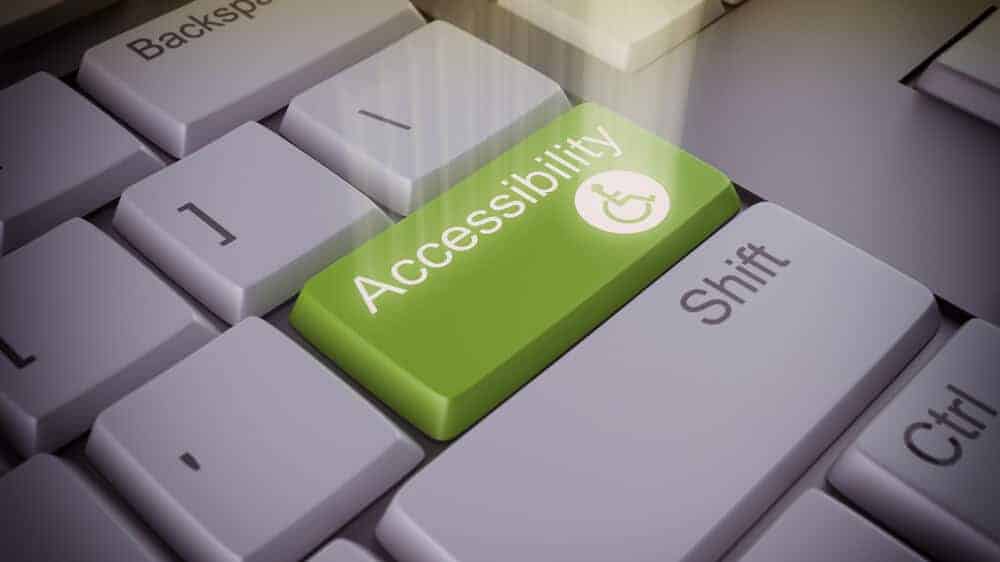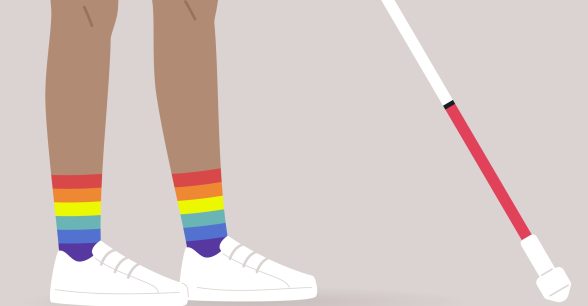How to Make Your Virtual Meetings and Events Accessible to the Disability Community
As meetings and events continue to take place in virtual spaces as a result of the COVID-19 pandemic, accessibility is too often an afterthought. Even event organizers and activists who normally work to make sure their in-person events are accessible seem to forget that virtual events need to be accessible for the disability community, too. Data from the Pew Research Center shows that disabled people are actually much less likely to use the internet, which may be in part because inaccessibility remains a serious barrier. So, let’s break down this barrier. Accessibility for virtual events should be a priority and central to the planning process from the beginning.
Planning your virtual event
Consider where and how your virtual events are taking place
As a starting point, think about the scope of your virtual event and what platform you plan to host it on. Disabled people are twice as likely to be unemployed or live in poverty, and internet access and devices like laptops, smartphones, and tablets can be expensive. “Provide information on how to access the event for people with limited or no access to internet at home, and be willing to share information offline too,” says Lydia X. Z. Brown, a disabled advocate, attorney, and adjunct professor. If you’re hosting an event over video conferencing software like Zoom, Google Hangouts, or GoToMeeting, offer the option for attendees to dial-in by phone and participate without a computer or internet.
If everyone will have internet access, what other technology might attendees need to fully participate? If the event is being held on social media (i.e., Facebook Live, Instagram Live/Stories, YouTube), do attendees need to have an account on that platform to take part? Have you looked into any accessibility issues inherent to the platform you are using?
Check out this guide: Best video conferencing apps and software for accessibility.
“I think that organizers should always be aware of the accessibility of the platform they intend to use,” says Keenan Provencher, a recent college graduate who is visually impaired and uses VoiceOver technology. Explore the accessibility features that are built-in to the platforms you’re considering for the event and determine what you might need to provide, such as captioning. Compare the different options available for hosting your event to see which is the best fit.
Include disabled people in your events
As you’re planning and creating events, make sure to reach out to disabled speakers, performers, and other talent who may be interested and available for your events. If you’re putting together a series of authors to read their work, include disabled authors. If you are organizing a comedy show, hire disabled comedians to be part of it. If you’re hosting a webinar series on money management, have disabled financial experts among your speakers. Disabled people should be present at every stage of your planning process: Invite and include them as speakers and assume that they will also be attending your virtual events.
Ensure access for people with intellectual and developmental disabilities
Your virtual events need to be accessible to people with intellectual and developmental disabilities. Access needs aren’t universal, so be open to exploring different tools and technology to make sure that your attendees have no problem attending the event.
“Organizers need to be patient with people with ID when explaining online platforms,” explains Liz Weintraub, the senior advocacy specialist at the Association of University Centers on Disability. “At first, I got really nervous about using Zoom and Adobe Connect because I wasn’t sure I could use them. But my colleagues were patient was me and if one way doesn’t work, then try something else.” Weintraub points out that not all online platforms are equally accessible so a willingness to experiment and try something else is important.
Noor Pervez, the community engagement coordinator at Autistic Self Advocacy Network, says that access needs around sensory issues, such as extremely loud videos, need to be considered for virtual events just as they would for in-person events. He also recommends “leaving in time to process information, such as a 10-minute break every hour or so.”
Weintraub suggests that event organizers “create a tip sheet for online platforms with directions so people will feel comfortable with online platforms.” The tip sheet can include step-by-step information about how to use the platform(s) and the option to attend training sessions about the platform(s) before the event. The most important thing for access, she says, is to be patient and not rush attendees.
What to do in advance
“Event organizers should always share what they are already planning to do to increase access for their events,” says Brown, “and how people who may have other access needs can request that those needs be met.” Make it possible for your attendees to (anonymously or with their name and RSVP attached) request that specific access needs be met. This is particularly helpful if someone has very individualized access needs outside of the ones you and other organizers have prepared for.
- Factor the costs of captioning, sign language interpretation, and other potential accommodations into your budget.
- Make sure the service you’re using to host the virtual event is compatible with assistive technology like screen readers.
- Ensure the platform you’re using allows for computer-based audio listening/speaking and phone-based audio listening/speaking.
- Make sure your events are accessible to augmentative and alternative communication (AAC) users by offering multiple ways for attendees to participate, answer questions, submit questions, and interact.
- Offer training sessions with event organizers/volunteers prior to the event on how to use the platform(s) the event will be hosted on.
- Offer all accessibility information upfront and publicly to interested attendees.
- Have an accessibility point person who can assist with troubleshooting or access issues and provide contact information for them.
- Give attendees the opportunity to (anonymously, if desired) share any additional accessibility requests that were not covered in the event’s access information.
- Share the format of the event (e.g. discussion vs. listening to a presentation, or something else) and how long it plans to run for so attendees can plan around their need to take breaks, arrive late, leave early, etc.
- Provide any written or visual materials ahead of time to give people an idea of what to expect and the ability to plan in advance. Be sure to use an accessible file format.
- Allow attendees to send questions and comments in advance.
- Give notice about questions that participants might be asked to respond to, even icebreakers (for example, “Everyone introduce yourself and say where you’re from”).
- Make it clear to attendees that they will have an opportunity to ask questions so they can prepare.
- Provide a glossary of terms that will be used during the event and define them.
- If you have chosen to use Zoom, take precautions to avoid “Zoombombing” and other security issues.
- Make sure everyone has access to any links or login codes they need to join a live video call ahead of time.
- Take a look at the Inclusive Design Principles and see how your event planning holds up to them. How can you be as inclusive as possible?
For more, check out these Accessibility Tips for a Better Zoom/Virtual Meeting Experience.
Preparing Virtual Invitations and Presentations
- Include detailed, step-by-step directions of how to get on the event and how to use the platform.
- Ensure that fonts are easy to read and text is large and has good color contrast.
- Be mindful of jargon, slang, and assumed knowledge to be inclusive of all attendees.
- Use plain language.
- Avoid ableist and other negative language.
- Ensure your slides are uncluttered and consider using images to help explain concepts.
- If you use images, include alternative text and image descriptions.
- Do not use flashing or strobing animations in a presentation or other materials you and other event organizers are creating. If you are including material that already has strobing or flashing, such as a showing of a film or television show, remove the strobing from the original material or skip that portion of the material. If you absolutely must include something that has flashing or strobing (which, again, should really be avoided at all costs), then you must ensure you put a very clear warning in place before showing the material.
- If you’re sharing pre-recorded video, be sure to describe what’s happening in the video and add captions using programs like Final Cut or Adobe Premiere, or apps like Clipomatic, Clips, Caption This, and AutCap.
- If you’re uploading the video to YouTube, you have the option to use automated captions and then edit those captions to fix any errors before publishing.
- Hire a professional to write captions for your videos, using websites like Rev, Alternative Communications Services, and ASLCaptions.
- Hire a professional to provide sign language interpretation; you can find ASL interpreters using resources like the Registry of Interpreters for the Deaf.
- Hire a professional provide real-time captioning through vendors such as National Captioning Institute, CaptionAccess, and Streamtext, especially for webinars and other events where speakers will be interacting with attendees and answering questions in real time.
Check out this video on 3 Ways To Make Your Content More Accessible For Disabled People.
Looking for an all-in-one guide on digital accessibility? Check out Rooted in Rights’ #AccessThat resources on transcripts, audio description, captions, and alt-text.
During Your Virtual Event
According to 3-Play Media, “To ensure your live-stream content is accessible, you’ll need three things: live captions, live descriptions, and a good audio environment.” Also, be sure to have a staff member or volunteer responsible for ensuring accessibility needs are met during the event.
Access for People Who Are Deaf or Hard of Hearing or Have Sensory Disabilities
- Make sure your audio is clear; poor audio quality can make it hard for people to access the event and/or use apps that can help reduce background noise on calls, such as Krisp.
- Have your speakers use a headset whenever possible if this is accessible to them to improve audio.
- Hosts and presenters should use a quiet room where they won’t be disturbed whenever possible.
- Mute all attendees but those speaking to keep background noise to a minimum so that attendees can easily hear.
- Ask people speaking to say their name every time they speak, so captioners and attendees alike all know who is talking.
For more tips, check out this article: How to help students with a hearing impairment as courses move online.
Access for People Who Are Blind or Visually Impaired or Have Sensory Disabilities
- Make sure the speaker’s face is well-lit and can be clearly seen.
- If there is a method that will be used to vote or flag who can speak next, make sure all participants can access the process.
- Describe live scenarios. For example, if you are presenting a live video tutorial of applying makeup, you could describe the process: “I am now applying a dark purple lipstick to my upper lip.”
- Describe any images, read any text that appears on screen, and describe anything that you gesture at as if you were explaining it to someone who isn’t in the same room as you.
For more tips, check out this article: 5 Accessibility Actions You Can Take When You’re Moving Your Conference or Classes Online.
Access for People Who Are Intellectually or Developmentally Disabled
- Be patient with your attendees when you’re explaining how to use online platforms, especially if they are new to the platform and haven’t used it before. Repeat information if necessary.
- Use accessible, plain language during the event and avoid using jargon.
- Build processing time/breaks into your event.
- Leave ample time for questions.
- Offer the option for anyone using chat boxes to have their messages read aloud to everyone during the event (either by using a revoicer or having an event organizer read them.
For more information on inclusive meetings, check out this Inclusive Meetings guide from the Autistic Self Advocacy Network.
After your virtual event
- Share materials in an accessible format.
- If your team live-tweeted the event or if a Twitter chat was part of the event, create a blog post or other easy-to-read collection of those tweets for anyone who was unable to participate live.
- Offer your attendees the opportunity to provide feedback about the event, including accessibility, to help you prepare to plan the next one.
- Make accessibility an ongoing, inclusive conversation in your community for all types of events.
Remember: Accessibility is a learning process
Even for disabled people, accessibility—and doing the work to make sure your own events are accessible—is a learning process. It’s important for all of us to acknowledge that others may have access needs that differ from our own. Instead of making assumptions, offer your attendees easy and clear ways to request their specific access needs be met and to provide feedback after your event, which you can use as a learning experience for the next one.
If you’re hosting smaller events tailored to a specific group of attendees, such as virtual webinars for your employees or sober community and recovery meetings to replace in-person ones, check in with that community. Make it an inclusive, ongoing conversation around access needs in everything you’re doing virtually so that everyone, including disabled people, has a voice in what platforms are being used and how.
We can all make accessibility a priority and remain open-minded to changing our processes, learning more, and creating events that are inclusive and welcoming to all.
About Rooted In Rights
Rooted in Rights exists to amplify the perspectives of the disability community. Blog posts and storyteller videos that we publish and content we re-share on social media do not necessarily reflect the opinions or values of Rooted in Rights nor indicate an endorsement of a program or service by Rooted in Rights. We respect and aim to reflect the diversity of opinions and experiences of the disability community. Rooted in Rights seeks to highlight discussions, not direct them. Learn more about Rooted In Rights




So strobing is literally never unavoidable. If you can’t be assed, your disclaimer needs to be “I didn’t give a fuck about not hurting epileptic people and I’m not sorry”
Accomodations are not optional for ANY disability. It’s hierarchy of disability bullshit to present only some as actually required
These are surreal times. With the latest COVID – 19 outbreak, the Government has restricted travel and social contact to safeguard you and your family. So Eventdex has built up an AI-based virtual meeting app technology that will help you in sailing through this tough period, the virtual business matchmaking that will be held through video conferencing. This is something new to you all. But they have developed this technology just to support us so that together we can overcome this tough period. It is cost-effective and affordable too. for more info visit here: https://bit.ly/3ennAC7
Excellent! Thank you for posting.
K,
hierarchy of disability
never heard the phrase used before
but I am very familiar with the bs
thanks for putting a label on it
so many times, if a resource they consulted doesn’t list an accommodation I’ve requested, the entity I requested accommodation from considers my request invalid and not something they are required to even try to provide and/or they offer something from the list as if it is an alternative to the accommodation I require